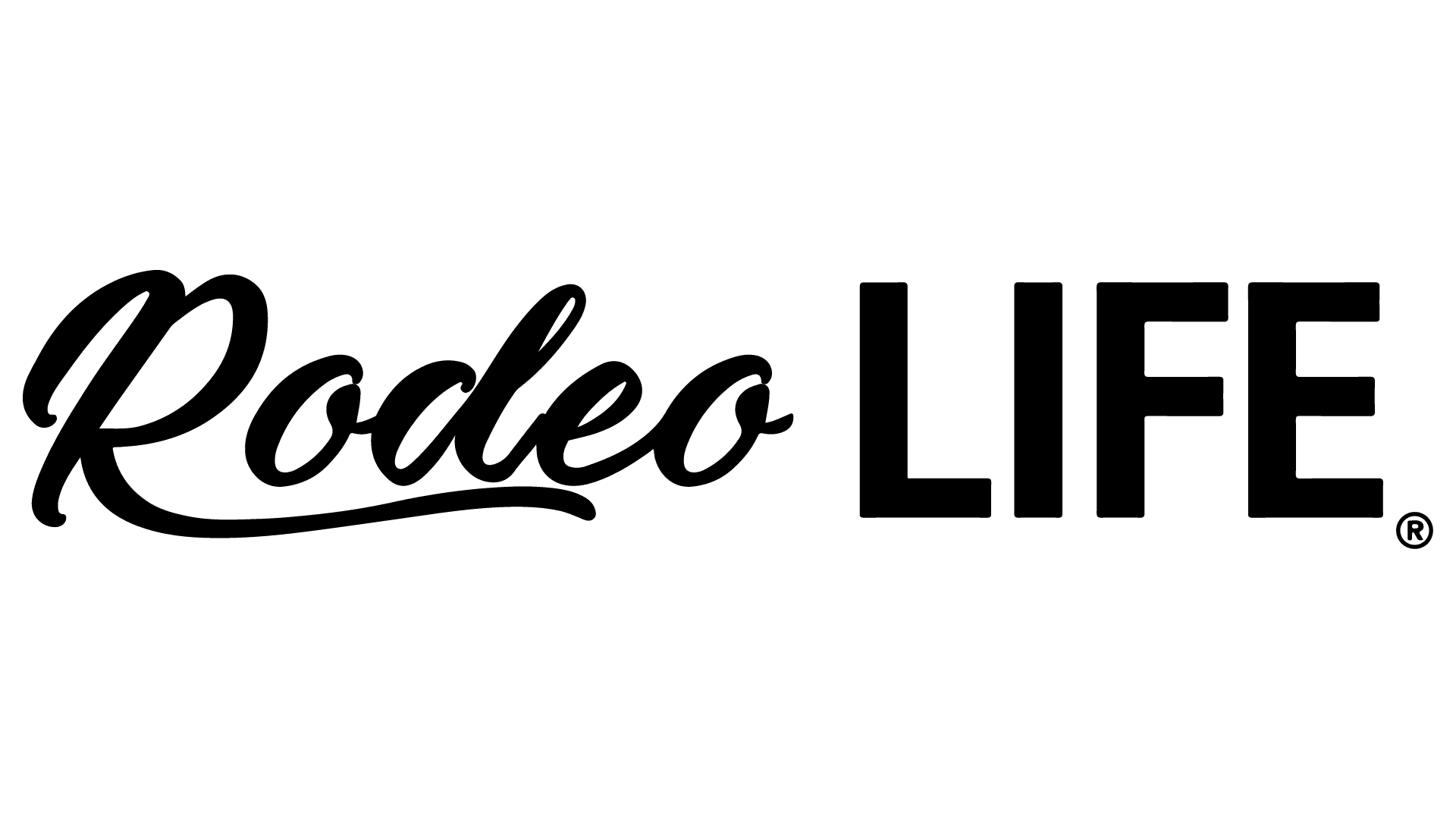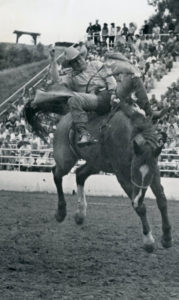
Jim on Big Horn in Brawley, California, 1969 – Foxie Photo
Jim Ivory admits he’s a gypsy, and that’s part of what has made him enjoy the rodeo world.
The cowboy, who grew up in northern California rode bareback horses at the National Finals Rodeo (NFR) four times, and has worked behind the scenes at rodeos across the world.
He was born in 1942, the son of Ed and Ellen Ivory, in the tiny ranching town of Alturas, California, the third generation of the Ivorys to rodeo. His dad worked on the ranches in the area, and “we were raised in those cow camps in the corner of Nevada, California and Oregon,” Jim remembered. Ed was a stock contractor, gathering bucking and saddle horses from the ranches and hayfields of the country. Jim and his siblings went along when it was time to rodeo. “That’s the only time we went to town, when the rodeos were going.”
He competed in junior rodeos in nearly every event. There was no high school rodeo association then, and kids ages thirteen through eighteen could enter the juniors. The family moved to Redmond, Oregon during his high school years, and he competed in amateur rodeos while in high school.
After high school graduation in 1960, he continued to rodeo. There were plenty of opportunities for it, too. “There used to be a lot of good amateur rodeos around there (California, Nevada, Idaho, and Oregon), and you could win a lot of money.”
By 1962, he got his Rodeo Cowboys Association (forerunner to today’s Pro Rodeo Cowboys Association) permit, and hit the rodeo trail professionally. One of the first pro rodeos he competed in was the Portland (Ore.) International Livestock Show. From there, he headed south to the Cow Palace, where permits weren’t accepted but he was on the labor list.
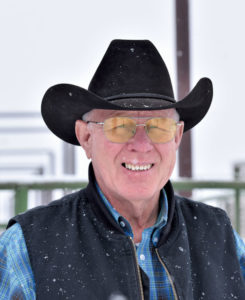
Jim Ivory – Rodeo News
He rode bareback horses professionally for four years, often serving on the labor list as well. He worked for the Christensen Brothers Rodeo Co., Beutler Brothers, Harry Knight, and Cotton Rosser, and frequently for his uncle, Buster Ivory, who had bucking horses and put on rodeos.
It worked well, riding and working at the events. “The first year I won $9,000 and it was all in the bank, because I had a job all the time.”
Working on the labor list, he did everything, flanking, driving truck, feeding and sorting stock. “I’ve done everything in the rodeo business except announce,” or work as a barrelman or bullfighter, he said. He rode bulls in the amateur ranks a bit but barebacks was his niche.
In 1967, the first year of four that he qualified for the NFR, he traveled with fellow bareback rider Jim Houston. Houston had asked Jim to travel with him, and Ivory was glad he did. “He refined my bareback riding,” Ivory said. “He made me a better bareback rider than I was. He was a great coach.” One year, Houston helped hone the skills of the three top bareback riders: Ivory, Paul Mayo, and Clyde Vamvoras. It was a testament to Houston’s good teaching skills. “He was a heck of a coach, because we all rode different but he had the ability to see what your natural skills were and how to improve what you did,” Ivory said.
Jim’s best year was 1969, when he finished second to the world champion, Gary Tucker.
After the 1970 season, he quit rodeoing professionally. The most rodeos he had competed at during a year was 77. “I didn’t like that much, rodeoing that hard,” he said. He also liked to have fun. “One of my downfalls was I thought I was supposed to have fun, so I didn’t do as good as I should have, but I had a lot more fun than a lot of them.”
He also knew he wanted to quit before he got to where he dreaded it. “I saw some of my old heroes, and they didn’t want to get on. They screwed around in the chute. I said, when this is no fun anymore, I won’t do it.” He could still win, but “it got to where I didn’t really like getting on.”
In 1972, in partnership with Australian bareback rider Jimmy Dix and Jim’s brother-in-law Van Vannoy, he shipped quarter horses, including a Triple A race horse, to Australia. He and his wife Cathy lived there for four years, taking care of them.
In 1975, he and Cathy came back to the U.S, and he worked at the Sunlight Ranch west of Yellowstone. In 1977, he began producing the Cody (Wyo.) Night Rodeo, which he would produce for a total of thirteen years (from 1977-1980 and from 1998-2006).
He also helped his uncle Buster produce rodeos in Europe in 1970, spending three months there as part of Rodeo Far West. The entire rodeo “outfit” was shipped there, including 100 head of saddle horses and seventy bucking horses and bulls. A few times in the 2000s, he took a group of cowboys to Brazil to enter their rodeos: Cody DeMers, Wesley Silcox, and Steve Woolsey, and Lewie Feild, as pickup man, among others.
Jim was part of a unique group: five cowboys at the 1967 and 1968 NFR had been members of the Redmond High School wrestling team: Jim, his brother John (a saddle bronc rider), bareback rider Ken Stanton, his brother Bill Stanton (a bull rider), and Larry Mahan, who did all three roughstock events.
Jim won’t agree that they were tough, but they were: “I don’t know if we were tough or not but we were tougher than some of them.” The Redmond bunch was a good rodeo group. “A lot of really tough rodeo kids came out of that group that I rodeoed with. Jack Thrasher, the Stantons, Buzz Seeley” and others. “We could go to those amateur rodeos and win a lot of money.”
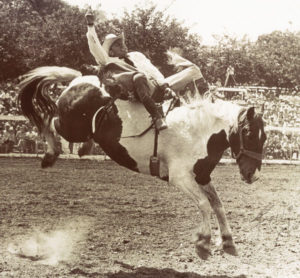
Jim bareback riding in Woodlake, California 1969 – Foxie Photo
The best bareback horse Ivory encountered was a horse owned by Reg Kesler. Three Bars, a 2004 inductee into the Pro Rodeo Hall of Fame, “was no doubt the best, rankest bareback horse there’s ever been,” Jim said. “She could throw everybody off, and it always hurt, for some reason. There’s been a lot of good ones over the years but she was unbelievable.” Three Bars was selected to buck at the NFR in three decades and won the bareback horse of the NFR in 1967, 1973 and 1980. Jim got on her twice, getting bucked off both times. “She almost killed me the first time,” he quipped, “and she did the second time.”
While he was on the rodeo circuit, Jim made Pampa, Texas his address, because his uncle Buster lived there. He loved Wyoming and Montana, and he and Cathy moved to Wyoming after marrying.
In his later years, Jim has shared his experience with Chad and Matt Burch of Burch Rodeo, and Chad loves working with him. He has an eye for bucking horses, Chad says, and they have bought many horses from him. “He knows what to look for with a horse. He’s seen a lot of them,” Chad said. “He’s a very smart man, and he’s been successful at rodeo.”
Jim has helped at many rodeos, including those for Burch, Reg Kesler, and Mike Cervi, among others. He’s raised a lot of horses that were sold to PRCA stock contractors and selected to buck at the NFR. Last year, Jim Dandy, a bareback horse whose mother Jim had sold to the Burches, carried Jake Vold to a sixth round win at the 2016 Wrangler NFR.
He and his wife live in Banner, south of Sheridan, Wyo. He still has a half-interest in two studs and three mares, and continues to help the Burches with their rodeos but doesn’t do as much as he used to. When Chad asked him to come to Kaycee, Jim told him he was too crippled to do anything. “I’m just a pretty face,” he told Chad, and Chad replied, “that’s what we pay you for,” Jim laughed.
He and Cathy, who married in 1969, have four children: sons Buster and James, daughter Mandy, and a daughter Kelly Jo, who passed away when she was four years old. Buster lives in Gillette and has two daughters and a son; James lives in Virginia with his two daughters and son, and Mandy is in Australia with two children.
Looking back on his rodeo life, Jim can’t imagine doing anything else. “I really liked to get on bucking horses, and the lifestyle and the people, the freedom and the money. It was a lot better than working on the ranch.
“I’ve been playing cowboy since I was three years old. That’s all I ever did, and I’m still playing it.”
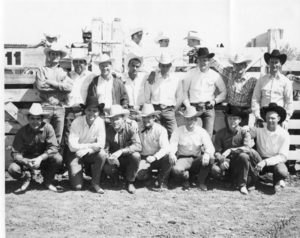
Red Bluff 1969. First row: Ace Berry, Ralph Maynard, Jim Ivory, Jerry Hixon, Clyde Longfellow, John Ivory, Don Flannigan. Second Row: Bill Martinelli, Manuel Enos, John Hawkins, Louie Zabala, Bill Stanton, Sonny Johnson, Bob Swain, Bob Edison – DeVere
